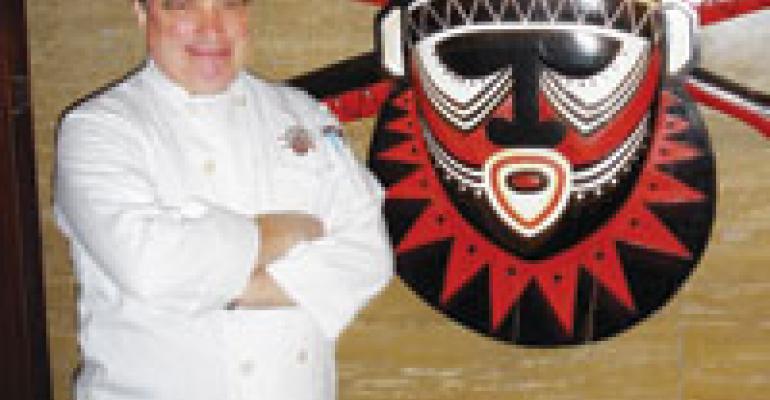Hans Aeschbacher says he has no interest in being a celebrity chef, but perhaps that’s because he’s had a great run as a chef to celebrities. While recounting his life as executive chef in some of Chicago’s finest restaurants, including 11 years at Smith & Wollensky, before becoming top toque at Trader Vic’s in May, the Switzerland native thumbs through a binder full of pictures and autographs of his famous fans.
There’s “Chef Hans,” as all the locals call him, with Michael Jordan, seemingly every Chicago Blackhawks player and even former President Ronald Reagan. Lou Piniella and Ozzie Guillen, the managers of the Cubs and White Sox, respectively, already have come in for dinner, but Aeschbacher jokes that he remains neutral and roots for both teams.
The same is true for the city’s culinary stars as well. He says he recently helped chef Charlie Trotter, his close friend for about two decades, celebrate his 50th birthday with a private dinner party. Trotter is known to drop by Trader Vic’s along with all the athletes and coaches from Chicago’s teams, Aeschbacher says.
Yet despite all the bold-faced names that followed Aeschbacher to Trader Vic’s from Smith & Wollensky or his previous jobs as executive chef at Lawry’s Prime Rib or the old Chicago Stadium and the United Center, he says Trader Vic’s turnaround will be built on his food and the restaurant’s service, not his famous clientele.
How did you get to know everybody?
I was executive chef of a French restaurant in the ’70s, and a local columnist used to bring a few stars and mention me in his column. I got to meet [Chicago Blackhawks players] Stan Mikita, Bobby Hull and Cliff Koroll, and I got involved with Mikita’s charity. Then I did [charity work for] cerebral palsy and the March of Dimes.
I’m in my fifth year as honorable chair of the March of Dimes fundraiser.
It’s a great career. You know, food is love. If you’re a passionate chef, full of service and love, nothing could go wrong. I’m not doing this profession because I want to be a TV star.
CHEF’S TIPS Measure your success by the number of clean plates returned to the kitchen.
Why did you move to Trader Vic’s?
I had a great time for 11 and a half years at Smith & Wollensky. I wish them well. I tell everybody, I’d love to have some of their business. I grew old there, and I have a different restaurant philosophy than the younger group. I’m old-school and old-fashioned. If it’s not first-class, it’s not the best, [and] I don’t want to be a part of it.
What were you up to before Smith & Wollensky?
I came back to Chicago [after a few years in Los Angeles with Lawry’s] and started to work for the Wirtz family at the old stadium. Probably, between Lawry’s and the United Center, those were the best bosses I’ve ever worked with. They gave you the material you needed to work with, and you could just blossom.
[After leaving the United Center] I had been doing some consulting. I decided I’d rather have a job because I found that if you do consulting and show them how to do their job, after a while they don’t need you anymore.
So I interviewed with Smith & Wollensky. I told them: “I can be the bridge between New York and Chicago. I can invite all those people you know I know.”
BIOGRAPHY Title: executive chef, Trader Vic’sBirthplace: Tüscherz-Alfermée, SwitzerlandBirth date: Jan. 1, 1944Education: culinary degree from SwitzerlandCareer highlights: meeting President Ronald Reagan; feeding Chicago sports teams in their locker rooms; cooking for the Los Angeles Dodgers and accurately predicting that they would win the 1988 World Series
We made a list and invited all those celebrities. We got involved in local charities, sports personalities came, and when people see that certain VIPs are coming, you’re the one that benefits. It’s like Gibson’s: There’s always somebody there, and now the bar’s a meeting place with always five or six people deep. This is what we want to create here.
I don’t want to put myself out there, but it’s necessary.
Where do you start in order to get that kind of business at Trader Vic’s?
Obviously, food has to be No. 1. You come to a restaurant for the food. Then we create an atmosphere.
We do chef’s tables, I give out dinners for two, and I comped a bunch of dinners for ESPN. A commercial with some star could cost you $1,000 a minute, but 10 dinners cost me only $1,000.
What are you telling your cooks in the kitchen now that you’ve taken over?
There’s a quote I’ve used all my life: Good food, good service and clean plates. Everybody thinks it’s simple, but that’s not easy to do.
So we have to change the culture so that the kitchen is ready and that we have the best we can offer, and the consistency of the food [is important].
You’re concerned about consistency, but how do you put your own stamp on the menu when you come into a new place?
I don’t know if it’s my own. I mean, Chicago has 46 steakhouses. As soon as we have the new menu, we’ll offer [Trader Vic’s traditional] Chinese-oven-cooked steak or [let guests] have it grilled.— [email protected]




